


Cerro Gordo County Iowa
Part of the IaGenWeb Project
|
The Globe Gazette


CENTENNIAL PROGRAM (Detailed Programs on Following Pages)
A MUSICAL SALUTE TO THE CENTENNIAL
HOMECOMING AND REUNION DAY
THE NORTH IOWA BAND FESTIVAL
TRANSPORTATION DAY
CENTENNIAL DAY
CENTENNIAL SPORTS DAY
FLOWERS AND DANCING
CHURCH AND COMMUNITY DAY - FLAG DAY
MASON CITY to CELEBRATE 100 YEARS SINCE BUILDING of FIRST CABIN by JOHN L. McMILLIN 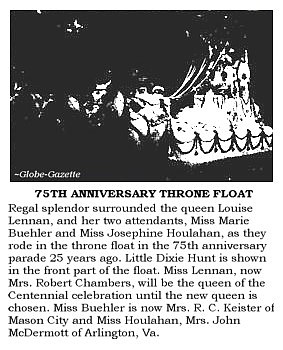 [Section 10, Page 2] With 100 bands, 100 queens and 100 years, with floats, reunions, a historical parade,
window displays, street dance, a sports program and a score of other events, Mason City's Centennial celebration June 7 to
14 is to be a colorful and spectacular event.
[Section 10, Page 2] With 100 bands, 100 queens and 100 years, with floats, reunions, a historical parade,
window displays, street dance, a sports program and a score of other events, Mason City's Centennial celebration June 7 to
14 is to be a colorful and spectacular event.Both a Centennial and a festival queen is to be named, bands will play and choruses and choirs sing, a historical play is to be presented, turning back the century of Mason City's life. The celebration will mark the passing of 100 years since John L. McMillin came from Rockford, Ill, and built the first log cabin in the northern part of the city. Honored as part of the celebration will be his descendants who are living here. With McMillin's cabin began the growth of a community that in a century of time became the Mason City we know today.
The eight day program will be filled with special highlights that will have wide interest. Meredith Willson will be here, as will other distinguished former Mason Cityans and former North Iowans. Willson, who has composed a Centennial March for the occasion and has been here for two previous band festivals, will have a significant part on the program, particularly at Monday's reunion, Tuesday's band festival and Wednesday's luncheon with the 10 Centennial queen candidates. The week's program gets under way with a music salute to the Centennial Sunday night, and a special homecoming and reunion is a arranged for Monday. Tuesday will see the largest band festival in the city's history with a queen and a band for each of Mason City's 100 years of history.
Ten Mason City girls have been chosen as candidates for the ruling queen of the Centennial. Each of these will ride in the historical parade Thursday evening, representing a decade of the city's existence. One of them will be chosen queen and named and crowned at the special ceremonies at the Surf Thursday night. Until the new queen is named, the reigning sovereign of the Centennial will be Mrs. Robert Chambers, who as Miss Louise Lennan, was chosen queen of the 75th anniversary celebration in 1928. Mrs. Chambers will ride in the queen's float in the Centennial historical parade Thursday evening. The historical parade will unfold the story of Mason City's first century. The history of the city will also be presented in other events on the program. For three nights, Monday, Tuesday and Wednesday, Mason Cityans and visitors will have an opportunity to see "Our Century," Women's Club play, at the high school. Wednesday, which is Transportation Day, will have on the program a parade that will tell the story of transportation from the Indian pony to the airplane. Some 800 boys and girls are expected to take part in the Centennial Sports Day program Friday. Special events have also been planned for adults. Saturday will be both for flowers and dancing. The Mason City Garden Club is sponsoring a program to assist in the decoration of churches, with an accredited judge here for the occasion. In the evening on State between Federal and Washington, there will be a pavement dance, at which emphasis will be placed on the revival of old time dance steps and costumes of the colorful past. Sunday morning each church will have its own Centennial observance to wind up the week of the celebration, with a concert in East Park in the afternoon and a candle light procession and hymn service at the park in the evening. The Centennial celebration is sponsored by the Mason City Chamber of Commerce, which has the assistance of numerous organizations and individuals in staging the giant event. Scores of committees and literally hundreds of individuals have been at work on the event for weeks. Funds for the staging of the Centennial were raised among business and professional men of the community and represents an expense of approximately $17,000.
OPENING DAY, SUNDAY, JUNE 7 - Band and Chorus to Give Musical Salute to Centennial
The East Park concert will be presented by the Mason City Municipal band, the Mason City Chamber of Commerce Chorus and the Women's Semi-Chorus. The band, under the direction of Carleton Stewart, will feature the Centennial March, which Willson composed for the occasion. It also will play the Iowa Centennial March by Karl L. King. The chorus, under the direction of Clayton Wornson, will sing among other numbers the Mason City Centennial Song by Mrs. Ann Otzen Sutton. This event is expected to bring a record crowd to the park. Mason City's band has for many years been a favorite of the local residents. On this occasion a number of visitors are expected to be here. The Chamber of Commerce Chorus and the Women's Semi-Chorus were given a tremendous reception at the annual concert this year and many have expressed the desire to hear them again.
SUNDAY PROGRAM
The Philharmonic Society presented the oratorio "The Holy City" at the Methodist Church in January, 1898, to raise money for a public reading room. Old timers will remember the names of the singers who were: Miss Pearl Myers, Mrs. W. D. Allen, Miss Maude Blythe, Mrs. J. E. Blythe, Mrs. George Bowen, Miss Phoebe Ara Reade, Mrs. J. H. Billings, E. R. Bogardus, Burr Keeler, George Lyon, Bert Wood, Walter Paul, Guerdon Vermilya, Roy Rogers and W. E. Ensign. Harry Keeler led the chorus.
"Maybe most of our readers think kerosene barrels are painted just to look nice, but they ain't. It is to keep them from leaking. Before the discovery of this fact, during a long voyage or a long journey by rail sometimes half a barrel of oil would leak through the pores of the wood and evaporate. "So some sharp fellow began to study some way of preventing such a loss. He first painted a barrel blue on the outside and then filled it with water and allowed it to stand until it soaked up all it would. When the oil was put in the water kept the oil from soaking into the wood and the paint on the outside kept the water from coming out. "He got a patent on his discovery and now he sits in his office and draws his royalty of one cent on every barrel made to hold kerosene oil for shipment. He's got a might soft thing on oil barrels."
HOMECOMING, MONDAY, June 8 - Former Residents to Receive Big Welcome
The visitors also will be taken on special tours of the city throughout the week to see old landmarks and the progress that has taken place in recent years. The formal welcome for the visitors will be held Monday, homecoming and reunion day, at 2 p.m., at the Music Hall.
In charge of plans for the homecoming is a committee headed by Remley J. Glass, who will preside at the Music Hall program. Serving with him are: Dr. Hardy F. Pool, Ralph S. Stanbery, E. W. Clark, Roy V. Harris and George C. Senn. The Music Hall will be the headquarters for the visitors and old timers throughout the week of the celebration. A number of hostesses have been designated to have charge of the serving of tea and coffee. This project is in charge of an executive committee made up of Mrs. W. A. Carter and Mrs. Walter B. Rae, co-chairmen, Miss Margaret Bagley, Mrs. Belle Parker Jackson, Mrs. Hanford MacNider, Mrs. Howard O'Leary and Mrs. N. Levinson. Following is the homecoming program at the Music Hall at 2 p.m. Monday:
Invocation by Dr. Lloyd Gustafson, pastor of the First Methodist Church, oldest religious group in the city. Welcome in behalf of the city, Mayor Bruce. Welcome in behalf of the old timers, D. H. Fitzgerald. Welcome Song, Rusty Hinge Quartet. Response, Meredith Willson. A Pioneer Pianist Plays, Mrs. Esther Senior Stinehart. Address, "Mason City Then and Now," Ralph S. Stanbery.
Some Reminiscences by the old timers. Songs, Rusty Hinge Quartet. Benediction, the Rt. Rev. Msgr. Patrick F. Malone of St. Joseph's Catholic church, organized in 1864. Monday's events will include the unveiling of historical window displays in the downtown stores. This phase of the celebration, which is in charge of Joel F. Hanes, is expected to attract eager visitors to see articles used in the pioneer days on display. At 8 p.m. there will be a concert in Central Park, by the Mason City High School Band. During the intermission a ceremony will be held honoring the first white settlers in Mason City, Mr. and Mrs. John L. McMillin, whose descendants will be presented. At 8:15 p.m. the first showing of the Women's club historical play, "Our Century," will be given at the high school auditorium.
BAND FESTIVAL, TUESDAY, JUNE 9 - 100 Queens and 100 Bands Are Coming
More than 5,000 band members in colorful uniforms will be joined by school officials, parents, hosts of friends and others to make the day one of the most spectacular of the week's celebration. While the program of marching and music goes on all day, there will be two focal points of outstanding interest - the parade at 10 in the morning and the grand finale, with the massed band concerts and the coronation of the new festival queen at the Roosevelt field, starting at 5:30 p.m. Reigning as queen of the festival until that moment arrives when thousands watch with suspense the coronation of the new sovereign, will be Miss Gwendolyn Johnson of Ventura. This 18-year-old, blue-eyed girl was the selection of the judges fro 86 candidates last year. She has been at the State University of Iowa the past school year. Among the special attractions of the festival will be the participation once again of Meredith Willson, who will be in the morning parade and, with Mrs. Willson, be guest of honor at a luncheon for visiting bandmasters at the Hotel Hanford at noon. He also will have a prominent part in the evening event. Bruce Stengel, who delighted the thousands at the 1952 festival is coming back this year. He will appear in the morning parade and at the evening event at the Roosevelt stadium.
The queens, each one representing a community taking part in the festival with a band entry, will be feted throughout the day. Following the parade they will attend a luncheon at the Hotel Hanford and at 2:15 p.m. will be introduced at Central Park. Concerts will be held throughout the day. Before the parade the Mason City All Grade Band, under the direction of Stanley L. Davis, will play. In event of rain the parade will be held in the late afternoon. If it rains in the evening the finale will be held in the Roosevelt Fieldhouse.
Tuesday's Events 9:15 a. m. - Concert, Central Park - Mason City All Grade School Band, Stanley L. Davis, conductor. 10 a. m. - Parade of Bands, Queens and Floats. 12:15 p. m. - Hanford Hotel - Luncheons for visiting bandmasters and their wives, and for the queen candidates, Meredith and Mrs. Willson guests of honor. 12:30 to 4:30 p.m. - Band Concerts and Special Events, Central Park. 2:15 p.m. - The queens appear in Central Park and are presented from the band stand. 3:15 p.m. - Continuation of the Central Park concerts. 5:30 p.m. - Roosevelt Football stadium opens for grand finale entry of 100 bands, Bruce Stengel of Wisconsin and his Baton, the Manchester Marching Band, Crowning of Miss North Iowa, Meredith Willson, the massed bands. 8:15 p.m. - High School Auditorium, second showing of Women's Club play "Our Century."
It doesn't happen often that the town bully comes back in later years to be trounced by the boy he once terrified. That happened in Mason City many years ago, according to an account once given by the late Ab Gale. Back in 1869 the mill pond in Rock Glen was a favorite skating spot. Among the boys who went to skate on this pond was Ab Gale, when a newcomer to the city. Simeon Bunce, the hotel man's son, larger that the others, persisted in tormenting young Gale and eventually drove him from the pond. The one desire of his life at that time, Gale said later, was to get Simeon Bunce and whip him. The Bunce family moved away. But 10 years later - in 1879 - while a fair was being held northwest of town Gale, then grown larger and stockier, saw Bunce working for an operator of a wheel of fortune. "Don't you remember me?" Gale asked Bunce. "Can't say I do," replied the man. "Well, I remember you. We were kids together. You were the bully and big boy of the town, so you whipped me and drove me off the ice where we were skating," said Gale. "I always said i was going to whip you some day. Take off your coat." "Forget it," laughed Bunce. "I'm not going to fight you." "Well, I'm going after you," declared Gale. When the fistic engagement was concluded, Gale was the victor, a triumph he remembered and smiled over throughout his lifetime as banker and later supreme treasurer of the M. B. A.
QUEENS OF OTHER YEARS COMING BACK TO FESTIVAL
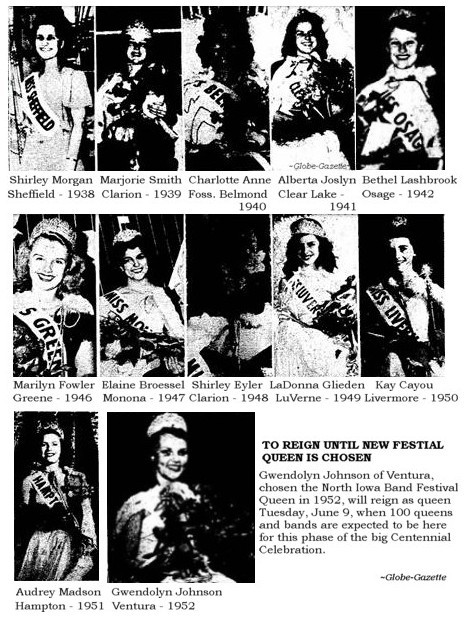
[Section 10, Page 7] Twelve North Iowa Band Festival queens have been named since the plan of having royalty at the big musical events was adopted in 1938. Most of these coming to the Centennial Celebration. The festival, which will be held Tuesday, June 9, will have as its reigning queen Miss Gwendolyn Johnson of Ventura until the new queen is selected. Miss Johnson was named as the 1952 queen. She has been at the University of Iowa the past year. The first of the queens was Miss Shirley Morgan of Sheffield, named in 1938. She is now Mrs. Res. Harrison of Indianola, and has three children. She, with her husband and two oldest children, will be here at the festival. She wrote to Mrs. Helen De Sart, chairman of the committee, that she was "thrilled to be coming to such a gala affair." The 1939 queen was Marjorie Smith of Clarion, now Mrs. John A. Ellsworth of Omaha, and in 1940 Miss Charlotte Anne Foss of Belmond was the queen. The latter is now Mrs. Henry A. Winter, Jr., of Denver, Colo. The 1941 queen, Miss Alberta Joslyn of Clear Lake, now Mrs. Reeves Hall of Independence, is planning to attend the festival with her husband, son of Editor W. Earl Hall of the Globe-Gazette, and children, David, Ann and James. Miss Bethel Lashbrook of Osage, the 1942 queen, wrote she would attend the festival, stating she still remembered how "nicely the queen candidates were treated." After a four year interval during the war the festivals were resumed in 1946, when Miss Marilyn Fowler of Greene was named queen. She is now Mrs. Arvid Lindell and still lives at Greene. Miss Elaine Broessel of Monona, the 1947 reigning beauty, is now Mrs. Glen Drahn of Belle Plaine. She and her husband, head football coach at Belle Plaine, have two little girls. She is making plans to attend the festival. The 1948 queen, Miss Shirley Eyler of Clarion, was graduated as a United States Air Line stewardess March 13 and is not expecting to come. Miss La Donna Glieden of Luverne, 1949 queen and now Mrs. Robert Reibsamen of Corwith, writes that she will be here. Miss Kay Cayou of Liverore, choice of the 1950 event, is attending Stephens College at Columbia, Mo., and plans to be here for what is expected to be the biggest festival of them all. The 1951 queen, Miss Audrey Madson of Hampton, is attending St. Olaf College, Northfield, Minn. She is eagerly looking forward to coming and having a part in the festival on this Centennial Year.
FESTIVAL STARTS AS SMALL MUSIC EVENT BACK IN 1936 [Section 10, Page 7] The North Iowa Band Festival, which now brings some 4,000 high school musicians to Mason City every June, had its inception in a modest musical event back in 1936. That year the Iowa Bandmasters Convention was held in Mason City and the Chamber of Commerce invited a few school bands to participate in a parade, concerts and other events during the day and an evening show at the Roosevelt Stadium, at which 17 bands performed in a massed concert. The event was so pleasing to Mason Cityans that they decided to try it the following year without the bandmasters convention. This time 27 bands responded. From that time on the number of bands grew steadily until the number reached the 50 mark in 1941 and 1942. The festival was then discontinued during the war. When it was renewed in 1946, it was one of the big events of Mason City's celebration of the Iowa Centennial. Since then the number continued to grow until in 1952 when 85 bands and queen candidates came to the festival. Noted band leaders have been invited to lead the great massed band performances. Frank Simon, well known band master and teacher and former conductor of the Armco band heard on the radio for many years, came on two successive years. Karl L. King of Fort Dodge, Iowa's famous march composer, was the guest conductor in 1951, and Gerald Prescott, director of the University of Minnesota bands, was here for the 1952 event. In 1948 and in 1950 Meredith Willson, Mason City's native son, distinguished composer and conductor, as well as the one-man Chamber of Commerce for this community, returned for the festival and a prominent part in its festivities. He and Mrs. Willson rode at the head of the parade and later reviewed it. He was the central feature for the bandmaster's luncheon and his compositions were sung and played at the finale.
100 QUEENS AWAIT CENTENNIAL BAND FESTIVAL Listed in Order of Appearance In Parade [Section 10, Pages 8 & 9]

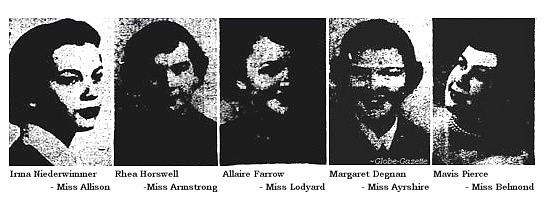
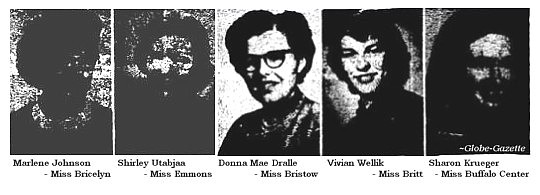
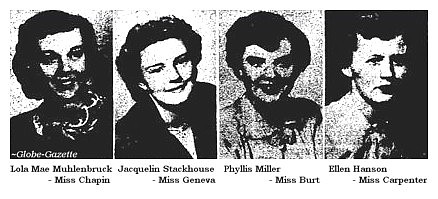
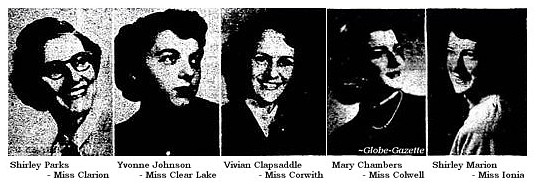
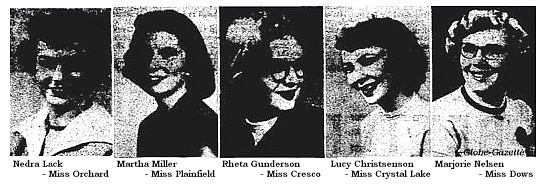
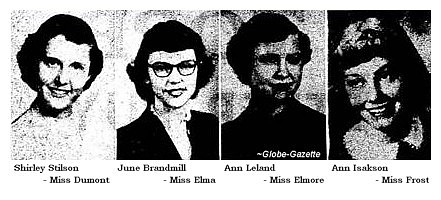
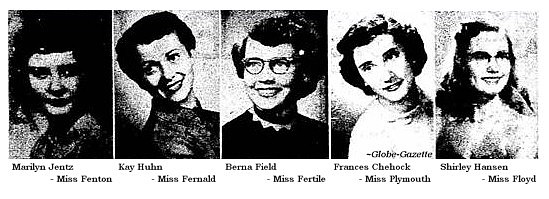
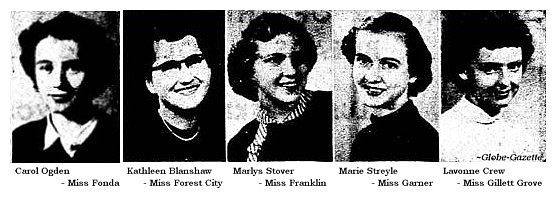
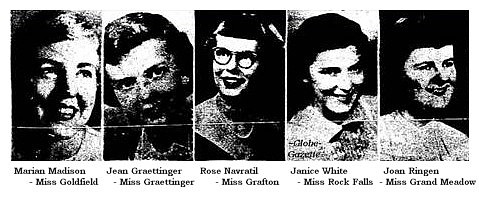
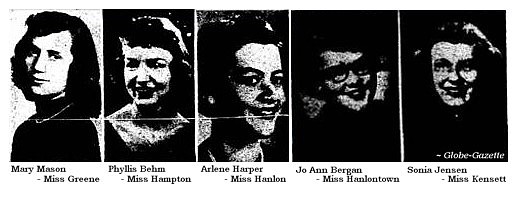
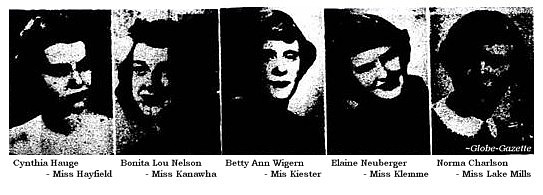
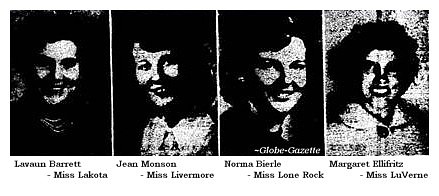
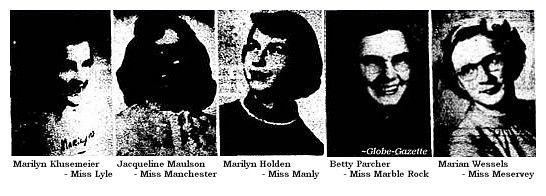
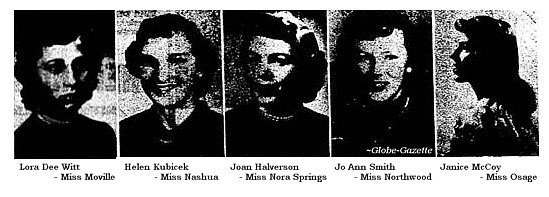
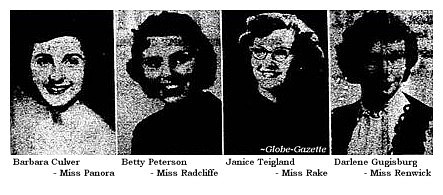
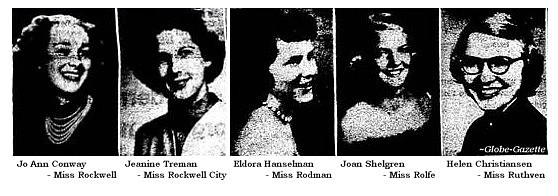
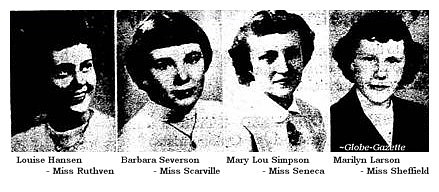
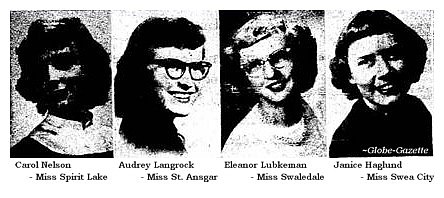

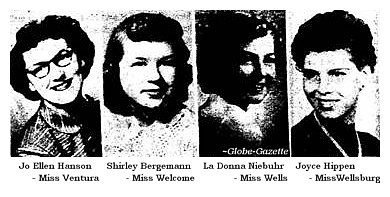
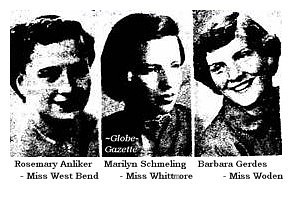
FESTIVAL FINALE, TUESDAY, JUNE 9 - Thousands to Watch Queen Coronation
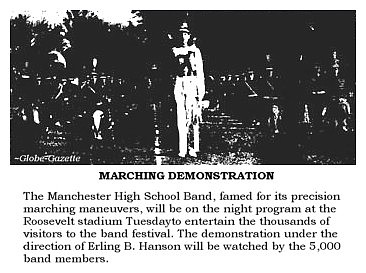
Other colorful events of the evening will be the marching demonstration by the Manchester High School Band under the direction of Erling B. Hanson, the greetings to the home folks by Meredith Willson and two performances by Bruce Stengel, the amazing baton expert from Wisconsin. Willson will direct the Mason City Municipal Band in his newly composed Centennial March, which is to be aired as a salute to the nation over Paul LaVelle's Cities Service program on NBC Monday evening, June 8. The one big event of the evening program, made up of many colorful numbers, will be the naming of the new queen from among the 100 contestants. Following this will come the coronation by Meredith Willson. The massed band numbers will be directed by both Willson and Carleton L. Stewart. The numbers will be selected from the following: "Officer of the Day," Lyone and Healy; "The Thunderer," by Carl Fischer; "Queen City," Fillmore; "Our Director," Walter Jacobs; "Washington Post," Carl Fischer, and "Iowa Band Law."
Tuesday Night 5:30 p.m. - Roosevelt Field opens to the public. Grand entry of bands begins immediately. 6:45 p.m. - Entry of the colors, color guard, queens and attendants, "Star Spangled Banner." 7 p.m. - Processional of the reigning queen, Miss North Iowa of 1952 (Miss Gwendolyn Johnson of Ventura), queens of other years, 1953 queens and hostesses. 7:30 p.m. - Bruce Stengel of Wisconsin and his baton. 7:45 p.m. - Marching demonstration - the Manchester High School Band - Erling B. Hanson, director. 8 p.m. - Meredith Willson greets the home folks and the band members, and directs the Mason City Municipal band in his Centennial March. 8:15 p.m. - Miss North Iowa of 1953 is announced and crowned. 8:30 p.m. - Bruce Stengle and his flaming batons. 8:45 p.m. - Massed band numbers directed by Carleton L. Stewart and Meredith Willson.
All the permanent stadium seats and the bleacher on the north side have been reserved for visiting bands and their chaperones. Bleachers will be available for the public on the entire west and south sides. The platform for the bands, queens and visiting notables will be on the east side of the field. The visiting bands will come to the baseball field, then through the southeast gate, starting their entries at 5:30 p.m. at 6:45 the entry of the colors, color guard, queens and attendants will take place, followed by a processional of the reigning queen, Miss Gwendolyn Johnson of Ventura, the queens of other years, the 1953 queens and hostesses. The queens will circle the field and take their seats on the platform, with Miss North Iowa of 1952 - Miss Johnson - on the throne. Later in the program when the new queen is announced she will ascend the throne and reign over the remainder of the program.
TRANSPORTATION DAY, WEDNESDAY, JUNE 10 - To Depict Century of Transport in Giant Parade
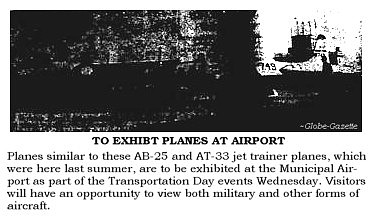
[Section 10, Page 11] The story of a century of transportation as it developed from the Indian pony to the modern airplanes and motor vehicles will be presented to Mason Cityans in a parade through the business section of the city and by exhibits at the airport Wednesday. The parade at 5 p. m. will be made up of all types of conveyances used by man on land, sea and in the air, according to C. W. Smith, chairman of the transportation committee. The observance of the day is to include a ceremony at the airport honoring Mason Cityans and former Mason Cityans identified with aviated. On exhibition will be a number of airplanes to be brought here for the occasion. The parade, starting on Federal at 4th, North, will go south to 6th, South, then east to Delaware and north to 3rd N. E. A special effort has been made to have both the old and the new of a number of automobiles, as well as trailer trucks, farm trucks and other vehicles, including scooters, boats and even an Indian pony. The aviation committee of the Chamber of Commerce, the Centennial committee and the airport commission will be hosts to the honor guest at the noon luncheon in the Aire-O-Room at the airport. Being honored at this occasion will be, among others, Kenneth Jay, Lester Barlow, Floyd Barlow, Charles Hathorn and Archie Peterson, all identified with the early development of aviation in Mason City and since then prominent in the development of the industry. In the group of guests also will be Gordon Gilmore, former Globe-Gazette sports editor who is now vice president of Trans World Airlines, and Col. Ron Fallows, and Howard Stoecker, who have distinguished themselves in military aviation. Resident Mason Cityans, who will be honored, include S. H. MacPeak and George Barrette, also identified with aviation here some years ago. Each of these will receive a commemorative scroll in memory of their visit to Mason City in a brief ceremony at 2 p.m. outside at the airport administrative building in order to give the public an opportunity to be present. Exhibited will be a number of new models of private planes to be flown in by midwestern distributors. Also to be shown will be an old Curtiss pusher biplane to be brought by the Phillips Petroleum Corporation, and a modern executive airplane to be flown in by the Standard Oil Company. Military aircraft also will be displayed, including a YF-64 Thunderjet and other planes. It is hoped to bring Lucky Lady, the B-50 which flew around the world in a non-stop flight. Some of the planes will be on exhibit by Tuesday for the benefit of band festival visitors. Assisting Smith on the general committee is Emil Bohn, Dick Mettler, Dick Selby, Frank Carroll, Ralph Shelton, Kon Hagen, J. H. McWaters, R. H. Conrad and Elmer Terrill. The aviation phase of the program is in charge of a committee made up of George Mendon, chairman, William Yenerich, Roger Lyons, Carroll Swift, Ray Tenney, Sylvan Hugelan, Dr. Harold H. Jennings, W. B. Hathorn and Dick Mettler. Wednesday's Events 12 noon - Luncheon for candidates for Centennial Queen at Hotel Hanford. The Centennial Committee, the Airport Commission and the Aviation Committee of the Chamber of Commerce are hosts at luncheon to visiting notables of the aviation industry in Aire-O-Room at the Airport. 2 p. m. - Brief program at airport open to the public. 5 p. m. - Transportation Day parade in downtown Mason City. 8 p. m. - East Park, regular mid-week concert by the Mason City Municipal Band. 8:15 p. m. - High School Auditorium, third and last presentation of the Women's Club play, "Our Century."
CENTENNIAL DAY, THURSDAY, JUNE 11 - Queens and Floats in Historical Parade
In this parade there will be more than 100 floats and other units depicting the history of the city over the past century.
The parade will include the 10 contenders for the 1953 title of Centennial queen, each one in an open car with costumes of each decade down through the century. The girls and the decade they will represent are:
Leona Wismer, 1853-63; Bettie Holvik 1863-73; Dianne Grimm, 1873-83; Shirley Kofoot, 1883-93; Marilou Gaffri,
1893-1903; Nancy Wilson, 1903-1913; Ann Boyd, 1913-23; Judy Taylor, 1923-33;
Leo Sweesy and his committee have been at work on this parade for weeks, getting the entries and organizing the giant lineup of units that will unfold the events of the past century. The parade will go south on Federal from 4th North, to 6th South and north on Delaware to 3rd N.E. The queen contenders will be special guests at the Centennial Ball at Clear Lake a 9 in the evening, staged under sponsorship of the Junior Chamber of Commerce. There the queen chosen by Meredith Willson, will be announced and the coronation ceremonies held. The Centennial queen will also be the Mason City Jaycee's entry in the Miss Iowa contest to be held at Clear Lake as part of Governor's Days. Buddy Morrow and his recording band will provide the music for the dance.
Thursday's Events 6 p. m. - Historical parade on Federal and Delaware Avenues. 9 p. m. - Centennial Ball at Surf in Clear Lake, where queen will be announced and crowned.
SPORTS DAY, FRIDAY, JUNE 12 - Centennial Sports Program, Field Day Planned

[Section 10, Page 13] Friday is the Centennial sports day and playday for boys and girls in Mason City. An all day program has been planned by a committee headed by Sam Edgar and Kenneth Church.
Friday's Events
9 a. m. - Checker tournament in Central Park and YMCA. 1:30 p. m. - Playday events at East Park. 2 p. m. - Horseshoe tournament at East Park. 3:30 p. m. - Golf driving contest at airport range open to men and women. 8 p. m. - Roosevelt Junior High Band in Central Park. 8 p. m. - Bait casting tournament for men in East Park. The day's program also will include special events for men and women, such as a horseshoe tournament at East Park, a golf driving contest at the airport range, a bait casting tournament at East Park and a checker tournament in in Central Park. Other members of the sports day committee are: Gordon Blanchard, Kenneth Hutzell, Robert Heston, Bud Suter, Leon De Rock and Vic Coyle. The boys and girls program will be held at the Roosevelt field in the morning from 9 to 12 and are open to both midgets (11 years and under) and seniors (12 to 16 years). Following is the Roosevelt field program 9 a. m. to 12 noon:
Other events will be held at East Park starting at 1:30 p. m. At the conclusion of the day ribbons will be awarded for first, second and third places in all divisions and a trophy awarded to the boy and girl champion. Following is the afternoon program:
M. J. Halson and F. M. Maxwell will be in charge of horseshoe tournament for men at East park from 2 to 10 p. m. The courts are lighted to permit evening events. Activities will be suspended from 5 to 5:45 p. m. A trophy will be awarded the winner. Ivan Fosse will be in charge of the golf driving contest for men and women at the airport range, starting at 3:30 p. m. and continuing until 8:30 p. m., with activities suspended between 5 and 5:30 p. m. The man and woman winner will receive trophies. A bait casting tournament will be held for men on the newly lighted softball field in East Park, starting at 8 p. m., with Hobert Duncan Sr., in charge. Following are the divisions: 5-8 bait casting, 3-8 bait casting, fly rod casting and free spin casting. A trophy will be awarded to the winner in each division. A checker tournament will be held in East Park, with Blanchard in charge. In event of rain the tournament will be held at the YMCA and in the evening the tournament will be continued at the Y. The tournament will get under way at 9 a. m. and continue until 10 p. m. A trophy will be awarded the winner. Many entries have already come in from all parts of North Iowa.
FLOWERS AND DANCING, SATURDAY, JUNE 13 - Garden Club Sponsors Church Decoration Program
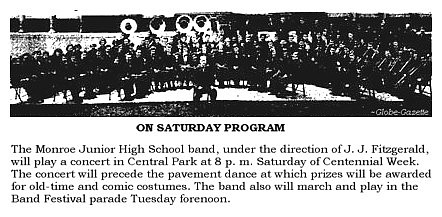
[Section 10, Page 14] Flowers - Go - to - Church is the theme of the Mason City Garden Club's observance of the Centennial and its plan incorporates the decoration of church sanctuaries with open house in the churches Saturday afternoon, June 13. Churches have been asked to decorate their sanctuaries with flowers grown by church members and the Garden Club is bringing Anna Hausen of Clarinda, an accredited judge, to award blue ribbons on the basis of excellence in decoration. There will be no competition in the usual sense.
The flowers will be judged between 10 a. m. and 2 p. m., June 13 and the churches will be open from 1 to 5 p. m. Each church will provide hosts for the afternoon. Mrs. M. L. Payne, chairman of the Garden Club's Centennial Committee, points out that the plan provides an occasion for Mason Cityans and Centennial guests to visit the community's churches, many of which are new or remodeled. It also gives an opportunity for church members to learn more about decorating with flowers. Saturday Events 1 p. m. to 5 p. m. - Sanctuaries of churches participating in church decorating program open to public. Flowers to be in place by 10 a. m. 8 p. m. - Central Park Concert by Mason City Monroe Junior High School Band. 9 p. m. - Up town Pavement Dance. Music by Earl Cawley and his special band.
Mason Cityans with visitors will have an opportunity to dress up in the apparel of bygone days in the Saturday night pavement dance that is to be held uptown. Old time dancing will be the vogue, with Lloyd Frazee of Bassett as the caller. First and second prizes of $10 and $5 each will be offered in four divisions, best old time costume and best comic costume for women and for couples. Earl Dean and Dave Diercks are in charge of the program. One of the first July 4 celebrations every held in Cerro Gordo County took place at the farm home of Richard Morris near Rock Falls in 1857. The celebration included fife and drum, exploding of powder on an anvil, a bountiful picnic dinner and dancing to the music of two violins. There was no oratory. Writing about it many years afterwards Charles B. Senior said: "A wonderful spirit of sociability and hearty good will pervaded everything, a spirit that was always present in pioneer gatherings and which can never be forgotten by those who have experienced it." On that day, Senior recalled, he first met H. I. Smith, who was about his own age, 12 years. The two became great friends. In 1857 roads and bridges in this county were non-existent, according to Senior. In coming to Mason City with his parents the month before the July 4 celebration, young Senior remembered that they crossed only one bridge and that was over the Turkey River at Clermont. There were no bridges over the Wapsie, the Cedar the Shell Rock or Lime Creek and the roads or wagon tracks over the prairie grass always followed the lines of least resistance to where streams could be forded. There were no fences and the only things to be feared were the sloughs, which were feared by every traveler. Most of the early settlers had teams of oxen, not horses, for oxen were adapted to conditions. A team of horses on sinking in would become excited and by floundering around make matters worse. Oxen were also better for pulling the breaking plows for breaking up the virgin soil. Senior, who lived on a farm in Falls Township, came to Mason City to make his home after returning from the Civil War in 1965.
CHURCH AND COMMUNITY DAY, SUNDAY, JUNE 14 - Candlelight Hymn Sing, East Park
This program, which will be presented from the band shell in the park at 8 p. m., will include a candlelight processional. Hymns of all faiths will be sung, the favorites of the participating churches, according to Clayton L. Wornson, who will be the director. This candlelight service, which will be a part of the Church and Community Day observance on Sunday, June 14, was planned by the church participation committee headed by the Rev. R. L. Williams. Other members of the committee are the Rt. Rev. Msgr. Arthur J. Breen, the Rev. Eric Biedermann, Rabbi Sidney Rothstein and the Rev. Robert Winger. Final Day Events Morning - Special services in Mason City churches, honoring visitors and pioneers. 3 p. m. - East Park, Sunday concert by the Mason City Municipal Band; family picnics and get-togethers. 8 p. m. - East Park, Candlelight procession and hymn service by singers from many of the churches of Mason City, Clayton Wornson, director. Sunday morning special services will be held in the churches, honoring visitors and pioneers. These will be occasions when churches can view their service to the community over the years and give recognition to those who have been leaders in their respective congregations. At 3 p. m. the Mason City Municipal Band is to give a concert in East Park for the particular benefit of those having family picnics and get-togethers.
QUEENS, TWIRLERS and MEREDITH WILLSON COMING TO BAND FESTIVAL [Section 10, Page 17] 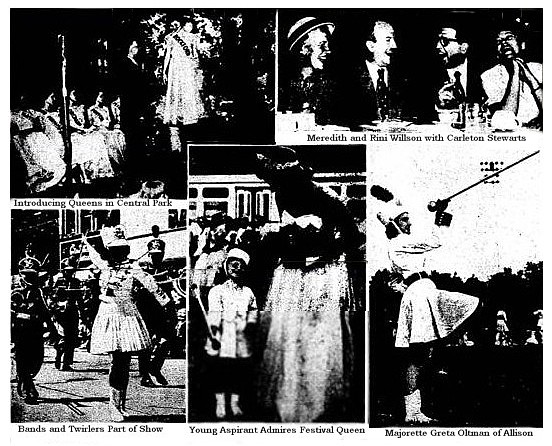
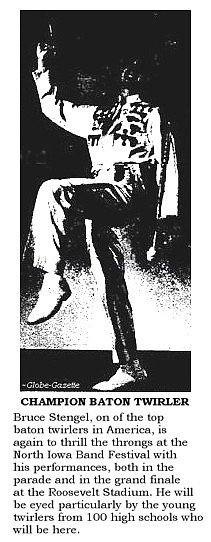
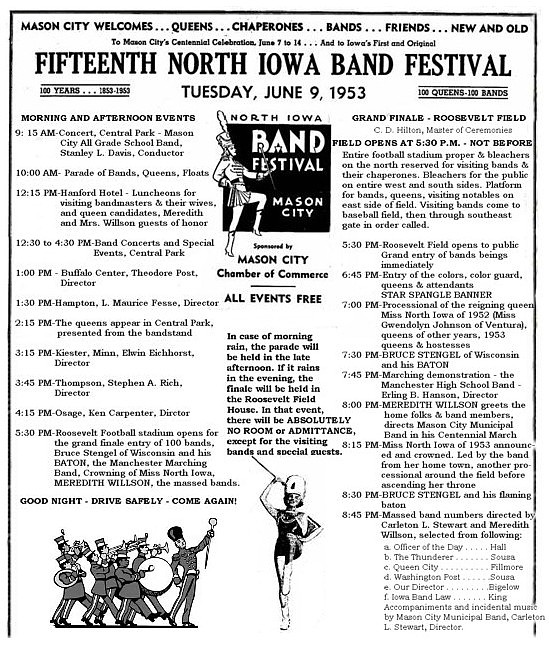
HUGE ORGANIZATION WORKING ON PREPARATIONS FOR CITY'S CENTENNIAL
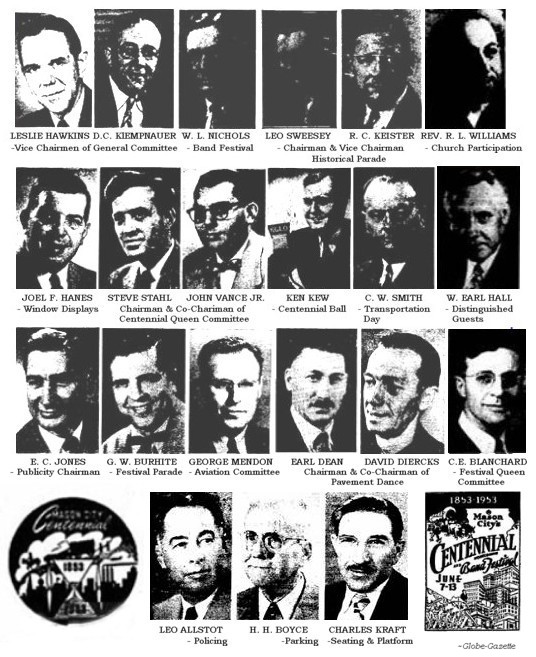
[Section 10, Page 18] Hundreds of men and women on numerous committees have been at work for weeks on preparations to celebrate Mason City's Centennial the week of June 7 and 14. Although sponsored by the Chamber of Commerce, the celebration program will be the work not only of that organization and the 50 or more committees set up to carry out the myriad of details, but of many other groups and individuals. Heading the list of committees are Gen. Hanford MacNider, honorary chairman; John D. Vance, general chairman; and D. G. Klempnauer and Leslie Hawkins, vice chairman of the general committee. Also on the general committee are E. C. Jones, George C. Senn, Dr. Hardly F. Pool, Enoch A. Norem and Lester Milligan, secretary. Working with this group are the following committees:
Assisting in this giant project are the following sub-committees:
Division chairmen f the historical parade are:
The band festival committee, of which W. L. Nichols is chairman and Dan G. Klempnauer, co-chairman, is made up of the following committees:
Judge to name Miss North Iowa - C. F. Weaver, president of the Chamber of Commerce, chairman, and the following heads of civic groups:
In addition to these there will be five votes from the women's committee. Meredith Willson reception committee - Dr. and Mrs. H. F. Pool, Mr. and Mrs. Tom Arthur, Mrs. Edna Bryant, Dr. and Mrs. William Egloff, Mr. and Mrs. W. Earl Hall, Mr. and Mrs. D. G. Klempnauer, Mr. and Mrs. Morris Laird, Mr. and Mrs. Lester Milligan, Mr. and Mrs. L. A. Moore, Mr. and Mrs. C. F. Weaver, Mr. and Mrs. John D. Vance, Mr. and Mrs. Carleton Stewart, Mr. and Mrs. Hugh H. Shepard and Mr. and Mrs. W. L. Nichols.
Mascia Club Organized 25 Years Ago [Section 10, Page 18] Mascia Club, composed of deaf citizens living in Mason city and vicinity, made its initial bow back in August, 1928 - 25 years ago when the Iowa Association of the Deaf (I.A.D.), then in session at Council Bluffs, voted to hold its 1931 convention in Mason City at the invitation of the Mason City Chamber of Commerce. The club members, then under the name of the 1931 convention fund club, worked in co-operation with the Chamber of Commerce towards raising necessary funds for entertaining the I.A.D. A little later an officer of the I.A.D. discovered that the I.A. D. would be 50 years old in 1931. So the association celebrated its golden anniversary in Mason City in such a way that it drew nationally known deaf leaders to come and address the I.A.D. convention. The Rev. F. C. Smileau of Columbus, O., president of the National Association of the Deaf (now deceased), gave out a history about the education of the deaf in the last 100 years and also acted as toastmaster at the association banquet at the Wedgewood Room in Hotel Hanford. Victor Skyberg, then superintendent of the Minnesoat School (now deceased) and Mrs. Petra Howard of St. Paul, chief of the rehabilitation bureau for the deaf, both acted as interpreters for those deaf leaders addressing the convention and also for those hearing ones addressing the same crowd which was of both deaf and hearing audiences. Mr. Gemmill, secretary of the State Board of Education addressed the convention too, and paid a fitting tribute to Edmund Booth of Anamosa, Ia., organizer of both the National Association and the Iowa Association of the deaf.
Einer Rosenjkar of Ida Grove, newly graduated from Gallaudet College, took up the temporary duties of the I.A.D. Secretary and kept minutes of the convention. He is now [1953] vice president of the National Fraternal Society of the Deaf; and lives now at Los Angeles, California. A. L. Roberts is still [1953] president of the Fraternal Society; and lives at Oak Park, Illinois. Tom L. Anderson, then principal of the vocational Department in Iowa School for the Deaf, was then at the I.D.A. convention and helped the Globe-Gazette reporters cover the convention. He had recently [1953] retired from work as chief of California. He was president during World War II, of both the National Association of the Deaf and the Gallaudet College Alumni Association. At present [1953] he lives at San Francisco, California. Palmer Lee, then of Hanlontown, now [1953] of Manly, acted as chairman of the huge I.A.D. picnic held a Clear Lake. Right after the convention, the convention fund club set to disband for good, voted to continue holding its meetings and parties as before and adopted the present name - Mascia Club - the word Mascia derived from the first letters of the words "Mason City, Ia." Since then the Mascia Club has held meetings and parties and also annual picnics at Clear Lake. The present [1953] officers of the club are: Mrs. Rudolph Kaplan, of Alden, president; Mrs. Carl Brand, of Forest City, vice-president; Walter Poshusta, of Mason City, secretary; Mrs. Walter Poshusta, of Mason City, treasurer; and, Carl Brand, Forest City, trustee. NOTE: Mascia Club is still active in North Central Iowa - North Central Association for the Deaf - with headquarters located at Fort Dodge. Other affiliates are located at Council Bluffs - Silent Club, Cedar Rapids - Association of the Deaf, Des Moines - Association of the Deaf, Inc., Sioux City - Association of the Deaf, Story City - Central Iowa Club of the Deaf, and at Waterloo - Cedarloo Association of the Deaf. The Iowa Association of the Deaf sponsors a newsletter entitled The Sign Language.
FORMER MASON CITYANS ARE INVITED HOME as DISTINGUISHED GUESTS [Section 10, Page 19]
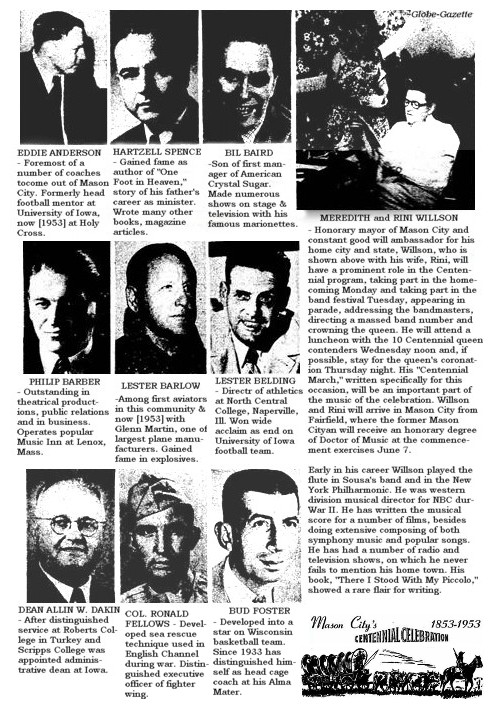
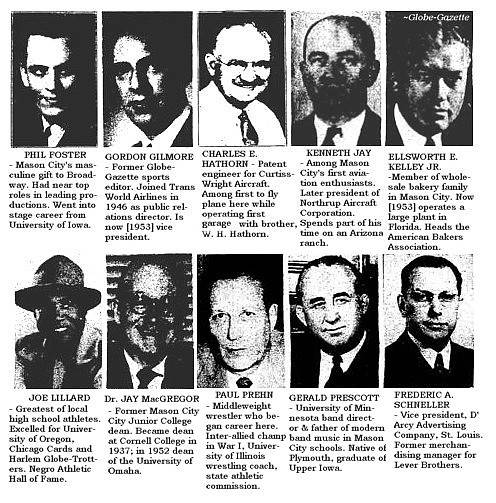
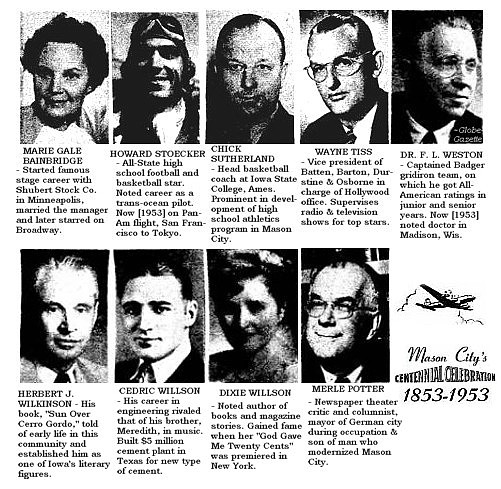
BAND STARTED GETTING NATIONAL RECOGNITION IN 1929 CONTEST TRIPS BEGAN UNDER G. PRESCOTT Start Playing in Elementary Grades
That year the band under the direction of Gerald S. Prescott went to Flint, Mich., to enter its first national contest. Mason City received eighth place in that contest and the next year was given a third at a national contest in Tulsa, Okla. In the fall of 1931 Prescott, who is now [1953] director of the University of Minnesota bands, was succeeded by Carleton L. Stewart. Under Stewart's leadership the high school band and orchestra entered nine national contests in addition to state contests and received a first division rating each time, except one year when the orchestra made second division. Division ratings came into use instead of placings. No national contest was held in 1932, but the Mason City band won first place in the state. In 1933 the band was in the first division at Chicago and the next year the national band contest was held at Des Moines and the orchestra meet at Ottawa, Kan. Mason City went to both, receiving first division ratings. Stewart continues to regard the 1934 band the best produced under his direction. In 1935 the orchestra got second division rating at the national, the only time a Mason City school musical organization failed to make first division in a national contest. In 1936 the band went to Cleveland and in 1937 the orchestra was at Columbus, Ohio, getting top honors. In 1938 regional contests replaced the national and in that and the following two years the Mason City band and orchestra got first division ratings at Minneapolis. in 1941 and 1942 both musical groups were at the St. Paul regional meets getting similar awards. With the war the contests were discontinued. Mason City's pre-eminence in band and orchestra is the product of a teaching system that starts boys and girls playing instruments in the grades and continues through the junior high schools, as well as the high school. This with the fact that skilled instructors have been provided has contributed to the excellency of this division of school work. As visible evidence of Mason City's interest in band and orchestra music was the construction of the Music Hall in the Central School grounds in 1934.
'OUR CENTURY' COLORFUL DRAMA OF MASON CITY'S 100 YEARS
[Section 10, Page 21] The story of Mason City's past, with its political battles, social events and such thrilling episodes as the arrival of the first railroad, is to be presented in a drama, "Our Century," at the high school auditorium Monday, Tuesday and Wednesday evenings during Centennial week. A cast of 100 persons, with 25 crew members, are at work preparing the play under the direction of Mrs. Jay Houlahan. Costumes and props have been borrowed from all over the city. Building crews have prepared stage replicas on flats of a covered wagon, log cabin, medicine wagon, railroad car, the monument in Central Park, in addition to drops, a set of tree wings and other scenery for the production. The play is to be presented in the form of scenes as reminiscences of grandmother, who is celebrating her 100th birthday. Mrs. Richard [Abbie Anna (1905-1994)] Romey will have the grandmother role. The production will be given free of charge. Reserved seats will be available for the asking next Thursday, Friday and Saturday at the Vance Music Company. Each evening's performance starts at 8:15 p. m.
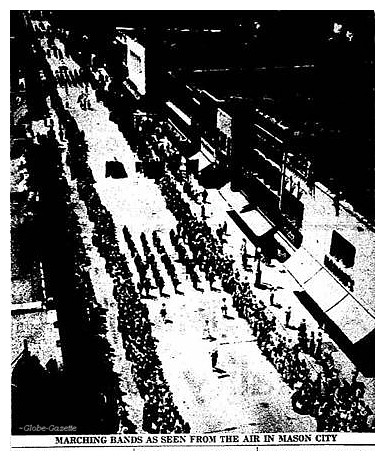
Five thousand band members from 100 communities in North Iowa and southern Minnesota will converge on Mason City Tuesday, June 9, for the North Iowa Band Festival. For all of them it will be an event to which they have looked forward throughout the year. Together they will make a mighty musical program at the massed band concert at the Roosevelt field in the evening. The festival will be a big event for the bandmasters also. They will be guests, together with their wives, a a luncheon at the Hotel Hanford at noon, at which Meredith Willson will be the speaker. Participating in the musical event with the visitors will be five Mason City bands, municipal, high school, two junior highs and the grade school organizations. Following are the bands participating in the festival and their directors.

CENTENNIAL FILM DEPICTS CITY PROGRESS
This film, "25 Years of Progress," depicts the commercial, industrial and cultural life of the city, emphasizing the changes that have taken place in the 25 years since the observance of the 75th anniversary. Adding to the interest of the film is the commentary by Chuck Hilton. Already shown before a number of groups, the film is available for other organizations and is booked through the Chamber of Commerce office. Many Mason Cityans, viewing the scenes inside some of the factories, commercial establishments and service companies, were amazed at changes that have taken place in recent years, particularly in modernization of operations. Scene include public and private buildings, churches, parks, playgrounds and improvements or new additions made in Mason City since 1928. Sponsored by the Chamber of Commerce, the film was produced through the co-operation of the Hawkeye Movie Makers Club. The committee in charge of the project consisted of Max Boyd, chairman; Em Decker, Charles Welland and Byron Seymour, technical advisors; Lloyd Goyer and H. H. DeGrush, camera equipment, and John Lord and Al Crowder, sound, with Max Minott doing the photography. This is one of a number of activities carried on by groups and clubs in addition to the actual program of the Centennial.
UNIVERSITY WOMEN FORM CLUB HERE [Section 10, Page 22] It as in March, 1905, in Miss Graves' English room in the high school, that the Mason City branch of the American Association of University Women was organized. Miss Elizabeth Graves was elected president; Mrs. L. T. Oldham, vice president; Miss Esther Steinberg, secretary; and Miss Eleanor McLaughlin, director. The state president, Mrs. A. H. Fuller, was in Mason City April 28 of that year to meet with the group at Garner. Miss Edith Naylor, who had already been a member, was on the program for the first regular meeting that year. In the fall the year's study was announced to be on Anglo-Irish literature. Mrs. H. E. Swarner was chairman of the program committee. During the summer, Miss Eleanor Hazlett had attended the biennial convention in Los Angeles. Among the charter members besides those already mentions were Miss Esther Pagenhart, Mrs. R. F. Clough, Miss Joy Ridgeway, Miss Mollie McGowan, Mrs. Loring Dorchester, Miss Ida Iverson, Mrs. D. K. Van Ingen, Miss Mary Bullock, Miss Dorothy Pagenhart, Mrs. R. P. Storvick, Miss Lillian Shimmick, Miss Edith Gibbs, Mrs. Grace Titus, Miss Luelda Carleton - 1953-54 president - Miss Grace Barnard and Mrs. L. L. Minor. Miss Helen Fullerton, who was then president of the Rockford branch, met with the group when organizing. The organization now [1953] has 43 national members and one associate member. The purpose of the branch is to unite the alumnae of colleges and universities for work on educational, civic and social problems of the community and to participate in the general work of AAUW.
CHAMP TWIRLER USES "FLAMING BATON"
A national twirling champion, 21-year-old Stengel has earned numerous awards at parades, football games, stage shows and music festivals through the country. He will lead the morning parade and appear at the grand finale at the Roosevelt field, at which he will give two performances, the latter one with flaming batons. Stengel started his career in twirling early in life. He combined twirling with dancing and and piano lessons while in the grades at Suring, Wis., where he got his start. Before high school he had appeared at the Wisconsin State Fair and on the stages of the Bay and Orpheum Theaters in Green Bay, Wis. He was a regular attraction with the Green Bay city band at the age of 9. While in high school Stenel was named to the Arion National Foundation for outstanding musical achievement. At Camp Randall in 1947 Stengel walked off with the Wisconsin twirling title and 23rd medal at the age of 15 years. He appeared at Chicago's giant music festival at Soldier's Field in 1948 after winning a preliminary tournament and took second place before a crowd of 95,000. At the 1949 city centennial winter carnival at St. Paul, Stengel was alternate drum major for the Milwaukee Railroad's Hiawatha band.
Bands will play in Central Park throughout band festival day. Following are the schedule of events in the park: 9:15 a. m. - Mason City Grade School Band, F. Stanley Davis, Director. 10:00 a. m. - Parade. 12:30 p. m. - Garner, Barbara Rankin, Director. 1:00 p. m. - Buffalo Center, Theodore Post, Director. 1:30 p. m - Hampton, L. Maurice Feese, Director. 2:15 p. m. - Queens are presented from the platform. 3:15 p. m. - Kiester, Minn., Elwin Eichhorst, Director. 3:45 p. m. - Truman, Minn., John E. Berg, Director. 4:15 p. m. - Osage, Ken Carpenter, Director.
MRS. DAKIN FOUNDER OF MONDAY CLUB [Section 10, Page 23] Monday Club, founded by Mrs. J. B. [Julia May (Church) (1841-1982)] Dakin, came into being in 1881. The history of its first 25 years was compiled by one of its 17 charter members, Mrs. John D. Glass, mother of Remley J. Glass. This early history can well be told by quotes from the record of this club historian. She wrote of the great need of study clubs for young women, whose parents "realized that a girl is better unborn than untaught" and that "study clubs were as natural, necessary and inevitable as an orbit for the earth." So, when "Mrs. Dakin's hand moved the magic wand and her voice gave the magic call, Monday Club was brought into existence." Mrs. Dakin was its first president and Mrs. Glass its first secretary. The other 15 charter members were listed as follows: Mesdames Hillyer, Emsley, Moulton, Wilber, Hudson, Bates, Randall, Shepard, Osborne, Card, Bush, Myers, Washburn, Wheeler and Herrick. The young Monday Club had no constitution, but when the club was federated such a document was demanded and written and, with very minor changes, still exists. The first study of those 17 members was McCarthy's "History of Our Times." "The purpose of the club has ever been intellectual benefit for its members," the early records sated. Its range of subjects for study has ever been wide - note a few of its varied topics: Hieroglyphics, Oriental Carpets, Child Labor, Dante, Geology of Iowa, The Indian Question, Astronomy, Browning and Shakespeare. When the club celebrated its 50th anniversary, Mrs. Alice Brown, mother of Mrs. William Hathorn, wrote a complete history of the organization. She wrote of the club's continued loyalty to its original aim, of "Literary and Social Culture," of the members lost and members gained, of the few occasions fun was mixed with work and of the continued benefits to all members. And these sentiments can only be repeated in bringing the club history up to 1953. The membership is still small, never exceeding 25, but the club continues to strive to maintain the ideals of the founders. The studies now [1953] include more of world affairs, but the times demand it and those founders would approve.
BAND PLAYED IMPORTANT ROLES IN EARLY DAYS
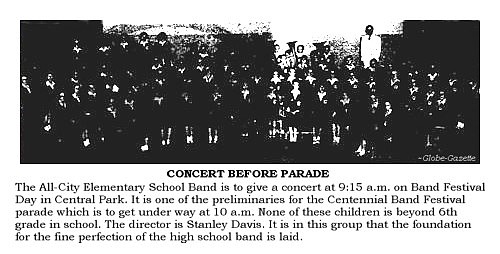
[Section 10, Page 24] Mason City has had many bands during its century, including the Rainmakers Band, so-called because it never failed to rain when that organization had a concert. Near the turn of the century it was the "Citizens Band," organized in the fall of 1896 with Harry Keeler as director. Keeler had been a member of several bands since the days he played cornet at Manly while still in knee-pants but this was the first Mason City organization of which he was director. In the fall of 1899 an attempt was made by Capt. E. W. Clark and others of the National Guard, just returned from the Spanish-American War, to have the Mason City unit become the regimental band. That honor fell to Webster City, however, because it was the residence of the colonel commanding. A benefit concert was given April 3, 1899, by the Citizens Band at Parker's Opera House - admission, 25 cents. "A good band is the cheapest band best 'ad' a town can have," says the program provided by Will H. Hathorn, one of the members. "This band was organized last fall with the intention of making it a permanent organization. Instead of trying to induce outside musicians to locate here, young men of sterling qualities from our own city were interested, thereby establishing an organization composed of home people to get the benefit derived from the drill and training imposed at the rehearsals. "The program presented are not for the private delection of a few cultured musicians, although we trust that they too will find some things of interest to them, but the main purpose is to please the people and by pleasing the people, enlist their good will and lead them gradually to a higher plane of musical understanding and appreciation. "We can only succeed in this most laudable enterprise through the encouragement and kindly support of the citizens, both of which we have received so far and confidently expect in the future." The band was assisted in the concert by Mrs. W. D. Allen, soprano, and Mrs. George Bowen, contralto. W. B. Terrill was president of the band and J. W. Adams, manager. The members included: Piccolo - "Shorty" Bowman; clarinets - Joe Dent, Joe Kennedy, Slocum, Fletch Emery, Harry Dyer, "Dad" Sheetrz, Geyer, Oscar Sumner, Long, Smith, Charles E. Hathorn; saxophones - Henry J. Steinberg, Will Terrill, Edward Loomer and McCleary; cornets - Harry Keeler, Lawton, Pat Cronin, Bahn, Charlie Prusia and Willis Bagley; trombones - Burr C. Keeler, John H. Greve, Carl Smith and Rollin Duffield; baritones - Wesley Thomas and Irving Smith; horns - Joe Adams, Johnson, William H. Hathorn and Stewart; basses - Frank Smith and Sheriff Jake Confer; drums - Ernest Hitchcock and Cliff McMillan.
QUEENS COMING BACK [Section 10, Page 25]
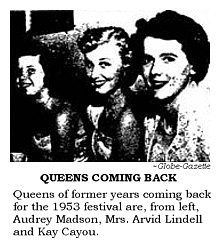
HOW MASON CITY GOT ITS POSTOFFICE
James Jenkinson reined in his horse at the door of McMillin's store and swung down to the ground. He had scarcely started unfastening the mail sack from the back of his saddle when there was an uproar from the store and from down the roadway where most of Masonville's population was bearing down upon him. "Hey, Jenkinson, got anything for us?" "Oh, Jim got a package for me?" "Tell us the news, Jim. Come into the store. What's the news back east?" Jenkinson went into McMillin's store, greeted his former employer, the excited children and Mrs. McMillin who assured him his place was ready for the night and "supper'll soon be ready, too. Lands, you must be about starved." The tall figure, dust covered from his long ride, presented a different picture from the slight lad who spent a lone winter on the prairie. This Jenkinson, three years later, was twice that number of years older in experience. Then, he had been a youngster in McMillin's employ, now he was an experienced plainsman, riding across the state from Dubuque to the Minnesota border to bring settlers their mail and the news. He was the all important link with an outside world. That night after supper a group of men and women sat in a circle around the McMillin home and listened to Jenkinson's account of his trip. They sat late, under the warm autumn sky, sparkling with millions of star points. Then, as the group started for their homes, the mail-rider yawned and dropped his mail pack, for safe-keeping, in a deep wash tub. on last look at the glory of the open sky and then bed. And that night softly, steadily and thoroughly the rain came down. The rider, exhausted, slept on unmindful of any earthly elements. But the next morning he was brought forcefully to life by a call from McMillin. Hastily jerking on his clothes, he rushed down. There was the tub half full of water and bobbing about like little boats or lying in sodden scraps on top of the water was ll the mail, papers and packages for North Iowa and points north of Masonville. A number of comments were made on the sight by all the settlers, not in the least forceful being Jenkinson's own idea of the situation. But the one that had the most far reaching result was Judge J. B. Long's "That settles it. Now we've got to have a postoffice." So one late sunny spring day in 1857, much less than a year after the wash tub episode, a cheering crowd inspected the new postoffice, a white building, built just for that and nothing else.
But the admiring throng was proudest of all of the new sign board on top of the little frame postoffice. There had been another postoffice of the name of Masonville in the state. Among the people there was consternation and disappointment for a time. Heads had been scratched in deep conjecture as to just what to do. But the answer now was there in bold letters for the world to read and know - "MASON CITY."
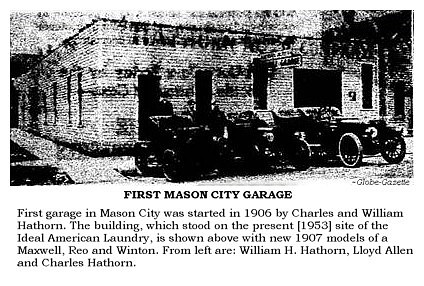
1903 CLASS REUNION PART OF CENTENNIAL [Section 10, Page 27] A significant event connected with the Centennial will be the reunion of the class of 1903 in the Mason City High School.

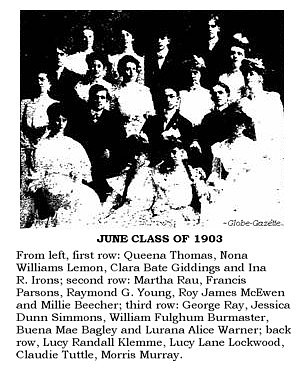
Just how many of the 42 graduates of the January and June classes of that year will show up has not been determined, but a number of the members are still residents in the old home town and the immediate vicinity. The reunion will get under way when the 1903 class will attend the Commencement exercises at the Roosevelt Fieldhouse June 4, invited by Principal P. O. Brunsvold to sit in a reserved section. This will be followed on June 8 by a 6:30 dinner at the Hotel Hanford in the Flamingo Room. Following the dinner there will be an informal program with B. F. Zuehl as the master of ceremonies. The committee in charge of arrangements, beside Zuehl, are Carrie Pfahler, LeRoy Woodward, Ina Dickinson Irons, Lurana Warner and Roy McEwen. L. D. Ellis was the superintendent of schools when this class was graduated. Twenty-four members of the class got their diplomas Jan. 30, 1903, at the First Congregational Church. The following June there were 18 additional graduates who were given diplomas, renting the Cecil Theater for their commencement exercises. These reminiscing classmates recall Mayme Farrell, Nellie Hanlon, Merle Marine, Martha Dunham, Guerdon Vermilya, May Parker, Anna D. Faye and Miss Mahaffey as some of their teachers. The June class had a mixed double quartet that sang at a social gathering of the January class. The January class had its sermon to the graduates at the First Baptist Church. The Rev. Johnson preached the sermon to the graduates for the June class at the First Christian Church, then on N. Federal and Fourth. His subject was "On and On." Most of the women in the two class groups have changed their names and become housewives. Two of the group became teachers and taught in Mason City for many years. The men have gone into business or professions. Many of the group have chosen California or other Western states for their home, but at least eight have remained in the Middle West.
GASOLINE, OIL TRANSPORTED BY PIPELINE FROM OKLAHOMA

[Section 10, Page 28] Thousands of gallons of gasoline or fuel oil distillate, or both, are delivered on an average day by railroad tank cars and motor transports from the Great Lakes Pipe Line Company terminal on the eastern outskirts of Clear Lake to jobbers and retailers over a widespread area. This pipe line terminal is comparable in purpose to the freight terminals of other forms of transportation. This giant pipeline system from the oil fields of Oklahoma and Kansas with the natural gas line from Texas, provide Mason City and the surrounding area with a highly efficient underground transportation system, in addition to those on the surface and in the air. The gasoline and distillates are transported from refineries in the oil fields by the Great Lakes Pipe Line Company, solely as a transportation operation. The company does not own a single one of the millions of gallons of products in its lines or tanks. Its sole function is transportation. Its own gasoline needs are purchased at service stations. Statistics of the recently enlarged facilities at Clear Lake, or Mason City as the terminal is designated in tariffs filed with the Interstate Commerce Commission, give an indication of the operational capacity. Total capacity of the 17 stock tanks is more than 24 1/2 million gallons, six motor transports can be loaded simultaneously, and there is space at the tank loading racks for 10 tank cars and switching accommodations. Loading is on a 24-hour basis, six days a week. In 1930 when Great Lakes Pipe Line Company was organized, movement of refined petroleum products long distances through pipe lines was pretty much an untested project. The original system consisted of a line from Oklahoma to Kansas to end terminals at Chicago, Minneapolis and Omaha. Other delivery points were located at Kansas City, Des Moines and Iowa City. Products were pumped through the lines to these locations and moved to final destinations by railroad tank cars. Construction of the 6-inch line from Des Moines to Minneapolis through Clear Lake in 1930-31 was this community's introduction to the pipe line carrier. A second 6-inch line along a parallel route to Minneapolis was built in 1938 and a 12-inch line in 1949-50. In 1942 with railroad tank cars urgently needed to move military supplies to the coasts, Great Lakes terminal facilities were modified to permit loading of motor transports as well as tank cars. Construction of the terminal at Clear Lake was begun in August, 1944. In its design was incorporated the knowledge gained from 13 years of operation in this new method of transportation. Despite delays caused by wartime material shortages, construction reached the stage that permitted the first trucks to be loaded from the terminal on Feb. 1, 1945. A tank car loading rack was added in 1947 and Oct.15 tank car deliveries began. Cars leave the terminal via the Mason City and Clear Lake Railroad to connections with the five railroads in Mason City where they are routed to various destinations. Transportation capacity of the Great Lakes system was increased 50 per cent in 1945-47 with erection of seven other delivery terminals included in the program. Hardly had this construction been completed than traffic needs were again equal and soon ahead of capacity. The postwar increase in automobiles and truck and the mechanization of farming operations to the point that horses were hardly more than a memory, along with convenience of distillate heating, had caused a demand far in excess of anticipation. In 1949 the pipe line company started on another expansion program that virtually doubled system capacity. At Clear Lake 10 tanks of 1,680,000 gallons capacity each were added, loading facilities were increased, and a new building constructed to house line manifolding equipment. As sufficient ground for the erection of 10 tanks was not available on the north side of the road that adjoins the terminal it was necessary to purchase a site south of the road for two tanks.
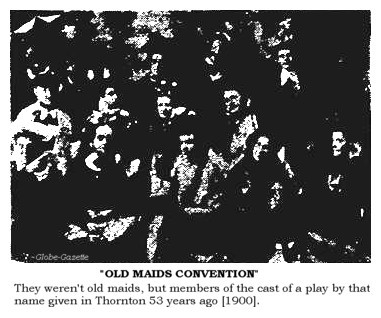
"COMPREHENSIVE CITY PLAN" GUIDE TO FUTURE
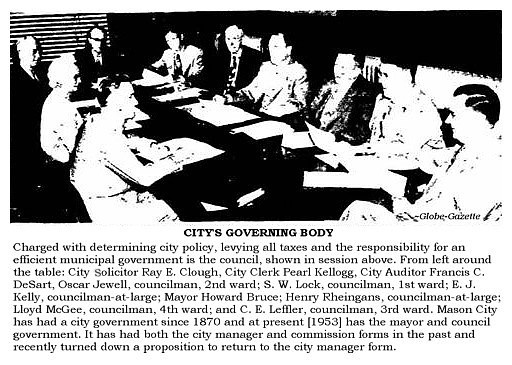
[Section 10, Page 29] As Mason City looks forward to a new century and wonders about the shape of things to come, it probably is appropriate to call attention to the fact that the city is in possession of a general guide to the planning progress of the municipality in a 200-page book entitled "A Comprehensive City Plan," prepared by Harland Bartholomew and Associates of St. Louis. Planning activities for Mason City go back to Dec. 14, 1925, when the city commission government passed an ordinance creating a city planning commission of seven members. Through the co-operation of the Chamber of Commerce and Mason City officials, the Iowa State College [present-day Iowa State University] of Ames authorized Rolland S. Wallis of that institution to issue on Feb. 3, 1926, "A Civic Survey" and a "Supplement of an Iowa Municipality" which became a preliminary report of a city plan for Mason City. Members of a planning and zoning commission were named and on July 25, 1928, the first zoning ordinance was adopted. On Sept. 7, 1937, the city government contracted with Harland Bartholomew and Associates, city planners for a plan for future development of Mason City. Two years were spent in making a study of the city. Seven committees of local citizens advised with the committee. On July 6, 1943, the entire Comprehensive City Plan was adopted and ordered published. Copies of the plan are available at the city hall and at the public library. The plan was placed in use as a textbook in the Mason City schools. The needs for such a plan were obvious. While Mason City had many desirable features, yet mistakes had been made during its development that could have been avoided had a plan been in use. Since no one was given the responsibility of looking ahead when a street was extended or cutoff, or when blocks were laid out, Federal Avenue is the only through street in the city. At one time the necessary wide through streets could have been obtained for nothing. Now considerable expense is unavoidable. Greater use could have been made of river fronts for parkways. Railroads run through the city in many places adding problems that could have been avoided if routes had been combined. A city plan exists to avoid such mistakes in the future and to provide a guide for possible development of through streets, future direction of growth and the zoning of industries, business and residences. The major objective of the plan is to provide the best possible urban environment of living and working conditions. In the final analysis, a city is not judged entirely by the freight car loadings, the amount of brick and cement produced or total number of people, but also by whether it is a good place to live and work. The engineers proposed both a circumferential or bypass routes and cross town routes to handle the increasing traffic in and through the city. They proposed making South Sixth and the combination of First N. W. and East State the main throughfares east and west, in addition to 19th South and 12th and 13th in the north part of the city. The north and south main routes, aside from Federal, would be Pierce, Carolina and Kentucky. Bypass systems would be provided to connect highways 65 and 18, making it unnecessary to turn from one to the other at the downtown intersections. The Bartholomew study on the school system has served as something of a guide in expansion of Mason City Schools. This included a new Washington school, enlargement of Harding, Jefferson and Wilson and Madison and the building of a new school in the northwest part of the city and in the southeast section. The plan proposed the erection of a third junior high school in the vicinity of East Park and a future high school in the area of 4th S. E. and Virginia. It was evident that Bartholomew envisioned a greater expansion in residential population to the southeast than is yet shown in the city's population trend. In the development of parks and parkways the engineers saw great possibilities in the development of the Legion golf course and the use of abandoned brick and tile quarries in the west part of the city as lakes. This, they believed, could be made into a beautiful and unique park.
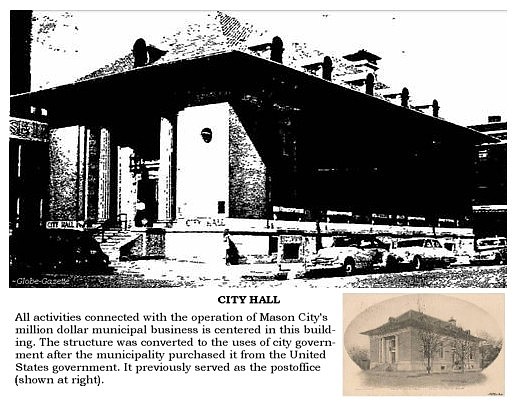
Three suggestions were made for possible location of a new courthouse with the view of adding other public buildings such as a city hall. The engineers regarded the courthouse as the immediate need of the community as the present [in 1953] structure is overcrowded, obsolete and unsafe. The present site, they contend, is inadequate.
PARK SYSTEM ACQUIRED OVER MANY YEARS
This park system was accumulated by purchases and gifts down through the decades. Central Park was given by the men who laid out the village a century ago. The first part of East Park was purchased in 1909 from A. G. Dunham for $10,000. More land was purchased from Mrs. and Mrs. George Gable in 1911. In later years additional acreage was purchased; dams and a retaining wall on Willow Creek constructed. In 1917, 3.64 acres were purchased from A. T. Parker and M. J. Parker and named West Park. The MacNider family recently [1953] gave a wooded area adjoining the park and additional land along the river bank was also acquired. The MacNiders also gave the 15 acre Spring Park on the north edge of the city. Parkers Wood, a beautiful 13 acre tract in west Mason City, was given by the family of A. T. Parker, who had acquired the land in 1874. The donors were Martha J. Parker and Belle Parker Jackson. In 1950 the city was given Denison Park on Highway 18 west of Mason City by the Mason City Brick and Tile Company. On April 1, 1949, the city took over the operation of Elmwood Cemetery which had been a private association from 1867.
FAMILY NAMES TRACE CENTURY OF MUSIC [Section 10, Page 30] (EDITOR'S NOTE: Mrs. W. H. Hathorn, a charter member of the Mason City Community Concert Association, discussed "Music in Early Mason City" at the Association's annual dinner. Her paper, in part, follows.) Early settlers had no time for anything but rapid, hard, necessary labor. They had few neighbors and these far apart. But they helped each other, building cabins and also prairie grass roofed shelters for the stock and these were occasions for merry-making. Because many of these people came down East where they had schools, after homes were built a great cry went back to the East: "Send us teachers." So schoolhouses were built, many used for churches until churches could be built. Everything was saved to take to school. They were avid for new songs, learned by note from someone else. The mother and children sang together, "Barbry Allen," "The Frozen Girl," "Billy Boy," "Fawn Footed Nannie," "My Dark-Eyed Soldier," old songs brought with then, or new. Along in the 70's there were more people closer together, more time to have fun, more new homes, many house warmings which would begin before dark, maybe in the afternoon. After supper a fiddle was tuned, whoever could called off and the dancing began. The children had their fun too, and always singing, school songs, hymns and new songs. Fourth of July was the biggest gathering of all the countryside. Boys engaged their girls a year ahead for the Fourth. Up at crack of dawn, chores were done, girls dresssed, lunches packed and after a two hours' drive of from 10 to 20 miles in a Democrat wagon hitched to a team, they arrived. After the oratory, discussion of crops and politics, the fun began, singing, dancing, eating and, I've no doubt, love making. Three musical families came to our small city in those early days. J. S. Wheeler, his wife and small daughter, May, came from Belvidere, Ill. Nettie Cotton Wheeler, his wife, was a graduate of Oberlin College, Ohio. She had a beautiful soprano voice and brought her Chickering piano with her as well as an old melodin, the kind held in the lap or on a table, where with one elbow one worked the bellows while one played with the hands. Their home became a social center and they were leaders in work in the new Baptist Church, built in 1869. The other families were descendants and relatives of Elisha Randall, including the Huntleys, Elders, Stanberys, Stevens, Bogardus and Denisons. Prof. Huntley, as he was called, was a fine musician, getting his education in Boston's New England conservatory. When the Methodist Church bought its first pipe organ, Prof. Huntley played it and taught others to play it, among them Letty Ellen Keerl, another member of the Randall family. When the Baptists bought their first pipe organ in 1878, it was Prof. Huntley who played it and taught May Wheeler to play it. It was the same with the Congregational organ a few years later. In the 90's when Chautauqua was held in Clear Lake in the old Pavilion on the Camp Grounds, Prof. Leslie came out from Chicago, trained choruses in the forenoon which sang in the afternoon programs as well as the evenings. People loved it. During the 70's and 80's there was a great temperance movement all over the East and Middlewest. Mason City was carried away with it. At one temperance club meeting, Prof. Huntley led in a temperance anthem of his own composition, Mrs. C. E. Mann sang a solo and a mixed quartet of Will Ensign, Mr. Huntley, Miss Maude Wilbur and Mrs. Gaylord sang. The newspaper reported: "A little girls' chorus sang prettily and Cora Thompson (afterwards Mrs. Charley Keeney) sang 'My Father's a Drunkard and My Mother Is Dead.' Well done, Miss Cora." As part of the July 4 celebration in 1872, the cornerstone of the old stone Central School was laid with a great deal of ceremony. It was at this function that Mr. Senior and his band played. The people from the entire county came to hear the speeches and there was one innovation. After the officer of the Board and the County had laid on cement to cover the box in the cornerstone (in which were the papers, coins and a Bible), one of the lady teachers was asked to add a scoopful, which she did and then, lifting high her scoop, led in cheers. She afterwards became Mrs. John Stanbery. The new pipe organ at the Congregational Church was played by Nettie Huntley. The women netted $50 from the concert which finished paying for the organ. On July 4, 1879, there was a grand celebration here with three balloon ascensions,martial and band music and oratory. A parade was held and J. D. Glass was president for the day. The veterans of the past wars marched. Citizens in carriages followed and after them citizens on foot. The Declaration of Independence was read, an oration given and a ladies' quartet of Misses Wilbur, Hudson and Montague and Mrs. C. E. Mann sang. People began to send their children away to school. May Wheeler's mother took her to Chicago in 1881 where she studied with Emil Liebling and Frederick Root. In April, 1882, advertisements of Litta were scattered everywhere. When Litta came she sang so beautifully she filled the musical hearts with joy. She was the equal of Aldelina Patti. Prof. Huntley named one of his daughters for her. Transcriber's Note: I believe
that Litta was Marie Eugenia Von Elsner Litta, an opera singer who was born in Bloomington, Illinois, on June 1, 1856.
She came from a musical family and received musical instruction beginning at age 16 at the Cleveland Conservatory of
Music and later in London, England. Prior to her 1878 debut in Paris, France, it was suggested that she change her
surname due to France's defeat in the Franco-Prussian War. She chose the name Litta, a surname of a prominent Italian
family. Of her performances, it was written that her voice was "a beautiful gift of nature", "fresh and pure", with "unusual
sweetness and evenness of tone", "clear and true as a flute". After her final performance in Escanaba, Michigan on May 9,
1883, she asked to return to Bloomington, which she considered her home. She died on July 7, 1883 at the age of 27. Adelaide Nielson of Brooklyn gave a concert assisted by May Wheeler, C. P. Shipley and others. There were many masquerades held and in one, C. H. McNider fooled everyone, going dressed as a lady. The Parker Opera House was built in 1883. It
seated 800 persons. It is the building now [1953] occupied by the Woolworth store and Hamilton School of Commerce. The
opera house was on the second floor. In 1894 Grace Senior had a program after being a student at Leipzig. The Monday Club had an "Evening of Music" with a talk on "The Elevating Influence of Music" by Mrs. Blythe and one by Winnie McAllister on "Wagner's Tetrology." Each guest was asked her favorite selection of music. "Yankee Doodle" was the favorite of one "because she could always recognize it." Phoebe Arz Reade had come to Mason City. She taught and sang. She had a beautiful contralto voice and gave a concert. The performers included Grace Senior, the Osborne Orchestra, Mr. Higgins and May Wheeler Moore. At Easter in the Baptist Church, Mrs. Moore had a double quartet "of ladies and gentlemen" with Bonnie Grace May Elder Dike at the organ. Another branch of the Randall family was that of John Stevens, whose daughters, Mable and Ruth, sang and played the piano. Miss Elder and the Stevens girls gave concerts together. Miss Mable Stevens had a bird-like voice and studied with Miss Reade and then in New York and Washington. She became the wife of Asa Adams but died very young. NOTE: Bonnie (Elder) Dike was
born May 9, 1875, and died August 13, 1966. Her husband, Chester Thomas Dike, was born August 13, 1870, and died August
2, 1958. They were interred at Elmwood-St. Joseph Cemetery. One concert of 1894 was a concert and cantata of "Singing Flowers" at the Baptist Church. The young beauties of Mason City stuck their heads through a backdrop painted so that each was a flower. C. B. Dake was the moon and Dr. Marston, the gardener. The Rainmaker's Band was organized and gave concerts. It was so called because it always rained when they gave a concert. Harry Keeler was the youngest member of the Iowa State Band and played a cornet solo. In 1894 Amy Dakin (Pool) was a happy little girl on New Year's Day when she got her piano. One of the popular music teachers was Mrs. McKeon. One could always tell her pupils because they flapped their arms. There had been many operas the preceding decade in which sang John Stevens, C. P. Shipley, Guerdon Vermilya, Herbert Quick, Will Ensign, and the Mmes. Moore, Allen, Bowen, Gaylord and Kirk. Harry Keeler went to the New England Conservatory of Music and afterwards taught in Kansas and in his own school here. Winnie McAllister and Maude Blythe were abroad. Madam Brauman had a school of music. Mr. Patchen had large classes. Choirs and choruses waxed and waned. We are heirs of 100 years of music, varied of course, but from the hearts of the people. I believe we've used it well.
Senior taught his three daughters, Grace, Esther and Rachel, and his son, Reuben, in various branches of music. Grace, a musical prodigy, could read at sight when 12 years old and played the piano accompaniment for the light operas given by amateur performers in the late 80's. Both Grace and Esther studied abroad and Rachel became violin soloist with Sousa for several years. Mason City's first civic orchestra grew out of the early band with which Senior was identified. Playing the violin himself, Senior added stringed instruments and for 15 years this organization played concerts under his direction. Senior was virtually self taught in his musical accomplishments. Early in life he became interested in violin construction, which became his lifelong hobby. He made close to 100 violins and continued this work until he was past 80. He died at Alhambra, Calif., in 1935 at the age of 90 years. Mrs. Esther Senior Stinehart lives in Mason City, Rachel Senior Merrill at San Gabriel [California] and Grace Senior at Hollywood, Calif. Another noted maker of violins in Mason City was Joseph Knovalinka. He operated a gun shop in Mason City for many years and became not only a skilled gunsmith, but also perfected the art of making violins. NOTE: Charles Berry Senior was born November 19, 1844 in Shepley, Yorkshire,
England, the youngest of a family of 10 children born to Valentine and Senior. Upon his mother's death which
occurred when he was six weeks old, Charles was raised by a maiden aunt and attended private school. At the age of 12,
Charles came to America with his father, settling on a farm near Rock Falls which was owned by Charles' brother Henry.
Upon the outbreak of the Civil War, nineteen-year-old Charles enlisted with the 7th Iowa Infantry, serving 1 1/2 years.
He was discharged in 1865 and then worked on the Union Pacific Railroad after which he returned to Mason City and
served as the county auditor. Charles and Grace Arabelle Elliott were married in 1872. When the Congregational Church
installed a small pipe organ in 1877, Charles served as organist and led the church choir. Mason City's first
brass band was organized in 1872 with Charles as a band member, playing cornet. Around the year 1890, Charles
purchased a property on Main Street where he owned and operated a restaurant for approximately 20 years. He
retired from the restaurant business to devote his time to making violins and the study of German and French
languages. Charles and Grace moved to California in 1924. Charles died on January 23, 1935, Albambra, California.
Grace Arabelle (Elliott) Senior was born in Canada on December 7, 1854, the daughter of
Abisha and Hannah Ann (Ford) Elliott, and died August 10, 1936. They were interred
at San Gabriel Cemetery, California. SOURCE: Charles Berry Senior obituary
FIRST CLASS BARNS ESSENTIAL FOR HOTELS [Section 10, Page 30] A small notice in the Cerro Gordo Republican for July 16, 1868, states: THE DAY'S BOUQUET [Section 10, Page 31] TO MRS. CARROLL ADAMS - for the completion of a successful year as president of the Mason City League of Women Voters. Her willingness to accept the responsibilities of leadership for a second year in this organization promises the community alertness in the interest of good government which is a League characteristic. REMEMBER? 10 YEARS AGO [1943]
20 YEARS AGO [1933] 30 YEARS AGO [1923]
40 YEARS AGO [1911]
SUNDAY IN MASON CITY [Section 10, Page 32]
Mr. Harmon, a native of Creston, has served nearly 11 years in the ministry. He comes here from Vinton where he served 4 1/2 years. Mr. Harmon has been pastor of churches also at Grand River and Afton and was for three years a traveling evangelist. He now is Iowa vice-president of the Assembly of God youth organization, Christ's Ambassadors. Mr. Harmon, his wife, Delores, and son Wesley, 7, live at the parsonage at 44 25th S. W.
Meditations The Rev. Charles Haigh, associate pastor of the First Methodist Church, will lead meditations Sunday at the Lenten Vesper service at St. John's Episcopal Church. The 4:30 p.m. service is one in a weekly series sponsored by the Mason City Area Council of Churches. The soloist will be Donald Fraser. Mrs. R. E. Patton is organist. The offering goes to "One Great Hour of Sharing." Mr. Stone will speak on "Companies of the Way."

Calvary - 4th N. E. on Delaware. C. D. Tieszea, pastor. 9:45 a.m. Sunday School. 11 a.m. worship service; guest speaker, the Rev. Wilbur Junker, Lyle, Minn. 6:30 p.m., youth hour. 7:30 p.m., Gospel service; sermon by Mr. Junker.
First - 1615 Delaware N. E. The Rev. Dale Harmon, pastor. Sunday School, 10 a.m. Worship, message by pastor, 11 a.m. 7 p.m., Christ's Ambassador's service. 8 p.m., evangelistic service. Mid-week service, Wednesday, 8 p.m. Central Heights - Sunday School, 9:45 a.m. Worship, 11 a.m. Evening service, 8 p.m. The Rev. Virgil Millard, pastor.
Bethel - 2243 20th S. W. Sunday school, 10 a.m. Church, 9 a.m., sermon by Dr. B. A. Rust, pastor. First- 125 E. State, the Rev. Ralph F. Johnson, pastor. 9:30 a.m., Sunday school. 1045 a.m., worship. (Nursery care for the little children.) 4:30 p.m., Junior High Youth Fellowship. 6 p.m., Senior High Fellowship. 7 p.m., evening service. Grace - 8th N.W. and Tyler, Carl J. Sentman, pastor. 9 a.m., daily KGLO Bible broadcast. 10 a.m., Bible school. 11 a.m., "Two Debtors" 7 p.m., expression services. 8 p.m., "The Christian's Warfare." Mt. Zion - 621 S. Adams, the Rev. George A. Kindrick, pastor. Sunday school, 9:45 a.m. 11 a.m., worship service. Subject: "For the People Had A Mind to Work." Installation service 3:30 p.m. The public is invited. The Rev. Seymour Gaines, Des Moines, speaker. St. John - 715 6th S. W., the Rev. Granville M. Williams, pastor. Sunday school, 9:45. Preaching 11 B.T.U., 6:30 p.m. Evening worship, 7:30.
St. Joseph's - Sunday Masses at 6, 7;30, 9, 10:30 and 12. The Rt. Rev. Msge. Patrick Malone, pastor; the Rev. P. C. Bodensteiner and the Rev. Paul Steimel, assistants. Holy Family - 711 Adams N. W. Masses at 6, 7, 8, 9, 10, 11 and 12:15. The Rt. Rev. Msgr. A. J. Breen, pastor; the Most Rev. Joseph M. Yuen, bishop of Chumatien, China; the Rev. Robert L. Spraight and the Rev. Donald J. Hawes.
First - Adams and 4th N. W., the Rev. Paul E. Becker, interim minister. 9:30 a.m., Bible school. 10:45 a.m., worship and Communion, primary church. Sermon "Christ in the Home." 4:40 p.m. Chi Rho. 6 p.m. C.Y.F. 7 p.m., young adults. (Nursery for infants at all services.)
First: 12th N.E. and Hampshire, Dale E. Erickson, minister. Bible school, 9:30 a.m. Worship with Communion, 1045 a.m. Sermon: "The Voice of the Crucified." Evening service, 7:30 p.m. Sermon: "The Act That Brought Down the House." Non-Instrumental - Services at 10:30 a.m., at YMCA. R. W. Abernathy, Phone 5882.
First - Washington at 3rd N. W. 11 a.m., Sunday service: lesson-sermon: "Reality." Sunday school 11 a.m.
First - First N. E. at Delaware. Robert L. Stone, minister. Church school and Father's Coffee Group, 9:30 a.m. Worship and supervised nursery, 11 a.m.; sermon: "The Greatest of These," by the pastor.
First - Maple Drive at Tennessee, Wallace R. Carlson, pastor. 9:45 a.m., Sunday school. 11 a.m., morning worship: "Confined to the Light." (Nursery for small children.) 6 p.m., youth groups. 7:30 p.m., evening gospel hour: "The Present Darkness."
St. John's - The Rev. Alfred R. Malone, rector. 8 a.m., Holy Communion. 10 a.m., Service of morning prayer. Sermon topic: "Whose Service is Perfect Freedom." by the rector. Church school classes for pre-confirmed children. Nursery during the worship hour. 11:05 a.m., classes for youth, adult forum, and men's roundtable. 4:00 p.m., Junior High Youth Fellowship. 4:30 p.m., Lenten vesper service with the Rev. Charles Haigh, First Methodist Church. Coffee hour after service. 10:30 p.m. Episcopal Hour over KGLO-radio, the Rev. Samuel Shoemaker preaching on: "How You Can Win Others to Christ."
Grace - Adams and 14th N.W., Marvin L. Hulse, minister. Worship services, 8:45 and 11 a.m. Sermon: "Gethsemane's Final Minutes." Sunday school, 9:45 a.m. Youth Fellowship, 7 p.m.
First: 124 Washington N.W., the Rev. Kenneth Goodberry, pastor. Sunday school, 9:45 a.m. Worship, 11 a.m. Evening service, 7:45 p.m.
Transfiguration - 1311 2nd S.W. The Rev. Demetrios Costarais. Saturday vespers, 4 p.m. Sunday: Orthos, 9 a.m.; divine liturgy, 10:30 to 11:45 a.m. Sunday school 15 to 25 years, 9:45 to 10:30 a.m.; 5 to 15 years, 10:30 to 11:20 a.m.
Kingdom Hall - 616 Delaware N.E. Watchtower study, 7 p.m. Subject: "How Jehovah's Witnesses View Their Ministry." and "Overseers of the Ministry."
Adas Israel Synogogue - 620 Adams N.W., Rabbi Henry Z. Ucko, rabbi. Services each Friday at 8 p.m. Religious school Sunday at 10 a.m.
Reorganized Church of Jesus Christ of Latter Day Saints - Services each Sunday morning in Decker Room of Y.W.C.A., 10 a.m. Worship at 11. Supervised nursery 10 to 12. Telephone 4251-J.
Bethlehem - Fifth N. E. on Delaware. 9 a.m., Sunday school and Bible classes. 10 a.m., worship. Pastor's sermon: "What Blessing Do you Expect From the Cross?" 10:30 a.m., the Bethlehem Lutheran Hours over KRIB: "Bringing Christ to The Community." 12:30 p.m. "This Is The Life" ovr KGLO-TV. Wednesday 7:45 p.m. Lenten vespers. C. A. Hinz, pastor. Central - 329 E. State, the Rev. Harold G. Kruger, pastor. 9:30 a.m., church school. 9:30 and 11 a.m. worship services. Reception of new members at 9:30 service. Nursery at 9:30 and 11 a.m. 6 p.m., Congregational Fellowship Supper, 7:30 p.m., "Church in Southeast Asia," study, Mrs. J. S. Westly, leader. Central Heights - Central Heights School. Service, 9 a.m.; Sunday school, 10 a.m. - John A. Moldstad, pastor. Gethsemane - (Wisconsin Synod) - 658 12th St. N.E. L. R. Schmidt, pastor. Hour of worship 9 and 11 a.m. Sunday school and Bible class, 10 a.m. Lenten service on Wednesday evening, 7:30 p.m. Immanuel - 5th S. E. and Jersey. Sunday school, 9:30 a.m. Adult and youth Bible classes, 9:50 a.m. Worship, 1045 a.m. Sermon: "Your Witnessing." Adult information class, 3 p.m. Lenten service Wednesday, 8:00 p.m. Message: "Come - for Personal Cleansing. S. E. Peterson, Pastor. Our Savior's - 2502 Jefferson S. W. Worship services at 8:30 and 11 a.m. Sunday school: Kindergarten and Grades 1-8 at 9:30; high school and adult Bible classes at 10:10. Luther League, 7 p.m. - J. Endersen, pastor. St. James - 4th S. E and Maple Drive. Church school, 9:15 a.m. Worship service, 10:30 a.m. Luther League, 7:30 p.m. Trinity - 216 2nd N. E. Roy A. Harrisville, Th. D., pastor; Lawrence E. Holst, associate pastor. Divine Worship service, 8:15 a.m. and 11 a.m. Sermon: "Now About Your Diet." Sunday school 9:30 a.m. Preschool and nursery 11 a.m. Senior League 7 p.m.
First - 119 South Georgia, Dr. George Truman Carl, minister, Charles F. Haigh, associate minister. 9:30 and 11 a.m. church school (double sessions) 9:30 and 11 a.m., worship. Sermon: "Hope Springs Eternal in the Heart," Dr. Carl. 5 p.m. MYF. Union Memorial - 610 4th N.E., the Rev.O. E. Blanks, pastor. 10:45 a.m., worship. Prayer service 7:30 p.m. Wednesday. Wesley - Pennsylvania at 14th S.E., the Rev. Paul Arnold Peterson, D.D., minister. 9:30 a.m. Sunday school. 10:45 a.m., morning worship. Dr. Peterson preaches "An Amazing Prayer." 4:45 p.m. Junior High M.Y.L. 5 p.m. Junior and Senior M.Y.F.
Church of Jesue Christ of Latter Day Saints - Sunday school, 10:30 a.m. YWCA Club Room, Elder Dallas Merrell, telephone 4518W.
Church of the Nazarene - 331 W. State. The Rev. Warren E. Burd, pastor. Sunday school, 9:45 a.m. Worship, 10:45 a.m. Young people's meeting, 7 p.m. Sunday night evangelistic service, 8 p.m.
First - 1702 Carolina S. E., C. W. King, Pastor. 9:45 a.m., Sunday school. 11 a.m., worship; sermon by pastor. 6:45 p.m., youth services; 7:30 p.m., worship, sermon by pastor.
First - Washington at Ninth St. N.W. - Church services at 9:30 and 11 o'clock. Sermon theme: "The Pure In Heart." The Rev. G. Robert Buttrick, minister. Church School at Washington School with all classes at 9:30 a.m.
Salvation Army - 201 1st S.W. Capt. Robert Stigleman, officer in charge. Sunday school, 10 a.m. Holiness meeting, 11 a.m. Young People's League, 6:45 p.m. Evangelistic service, 7:30 p.m.
Photographs courtesy of Globe-Gazette unless otherwise noted Some of the photographs did not scan well. In such a case the photograph has been substituted with a clearer copy if available. Transcriptions and Notes by Sharon R. Becker, November of 2014 Information obtained in notes from cemetery transcriptions, obituaries, biographies & other Globe-Gazette articles
|
Return to Centennial Program Index Page Return to Mason City Centennial Index Page Return to History Index Page Return to Cerro Gordo Home Page